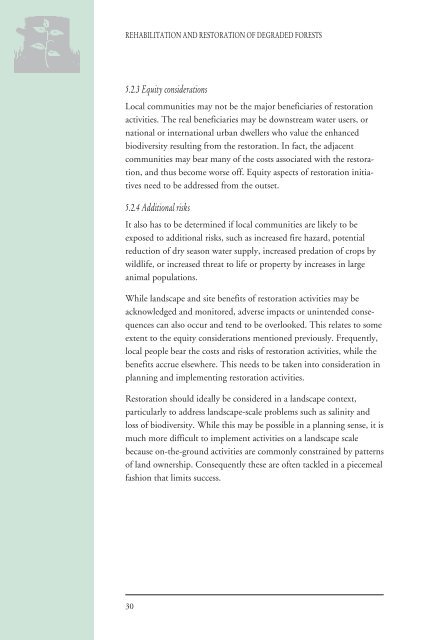Rehabilitation and Restoration Of Degraded Forests (PDF) - IUCN
Rehabilitation and Restoration Of Degraded Forests (PDF) - IUCN
Rehabilitation and Restoration Of Degraded Forests (PDF) - IUCN
You also want an ePaper? Increase the reach of your titles
YUMPU automatically turns print PDFs into web optimized ePapers that Google loves.
REHABILITATION AND RESTORATION OF DEGRADED FORESTS<br />
5.2.3 Equity considerations<br />
Local communities may not be the major beneficiaries of restoration<br />
activities. The real beneficiaries may be downstream water users, or<br />
national or international urban dwellers who value the enhanced<br />
biodiversity resulting from the restoration. In fact, the adjacent<br />
communities may bear many of the costs associated with the restoration,<br />
<strong>and</strong> thus become worse off. Equity aspects of restoration initiatives<br />
need to be addressed from the outset.<br />
5.2.4 Additional risks<br />
It also has to be determined if local communities are likely to be<br />
exposed to additional risks, such as increased fire hazard, potential<br />
reduction of dry season water supply, increased predation of crops by<br />
wildlife, or increased threat to life or property by increases in large<br />
animal populations.<br />
While l<strong>and</strong>scape <strong>and</strong> site benefits of restoration activities may be<br />
acknowledged <strong>and</strong> monitored, adverse impacts or unintended consequences<br />
can also occur <strong>and</strong> tend to be overlooked. This relates to some<br />
extent to the equity considerations mentioned previously. Frequently,<br />
local people bear the costs <strong>and</strong> risks of restoration activities, while the<br />
benefits accrue elsewhere. This needs to be taken into consideration in<br />
planning <strong>and</strong> implementing restoration activities.<br />
<strong>Restoration</strong> should ideally be considered in a l<strong>and</strong>scape context,<br />
particularly to address l<strong>and</strong>scape-scale problems such as salinity <strong>and</strong><br />
loss of biodiversity. While this may be possible in a planning sense, it is<br />
much more difficult to implement activities on a l<strong>and</strong>scape scale<br />
because on-the-ground activities are commonly constrained by patterns<br />
of l<strong>and</strong> ownership. Consequently these are often tackled in a piecemeal<br />
fashion that limits success.<br />
30

















